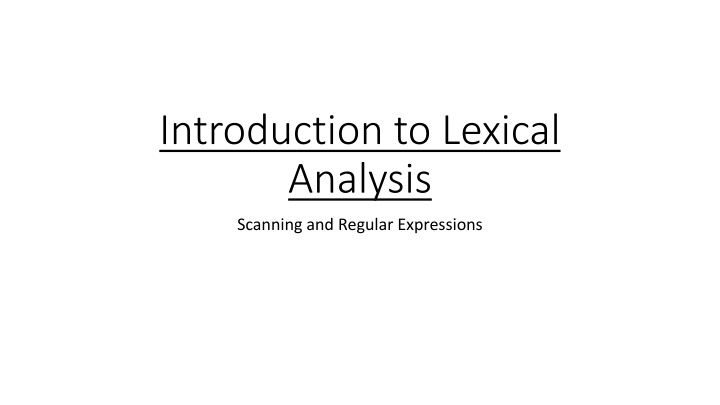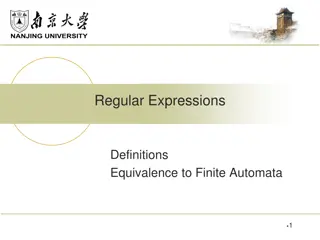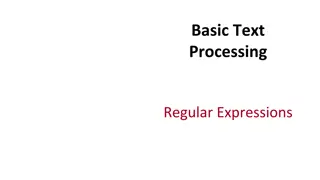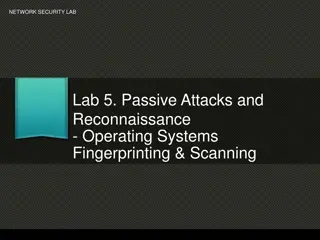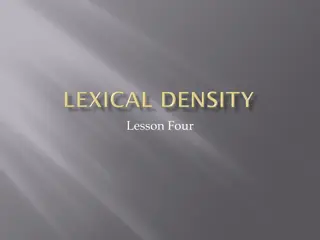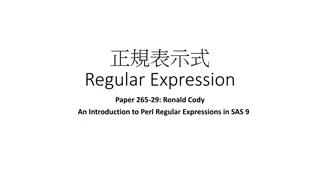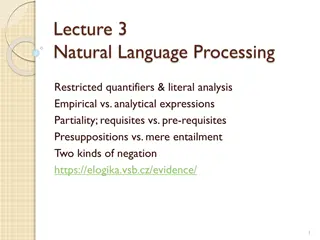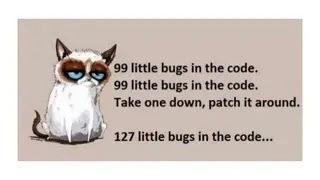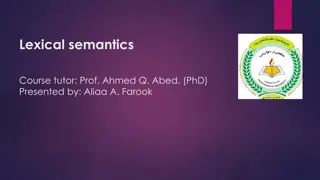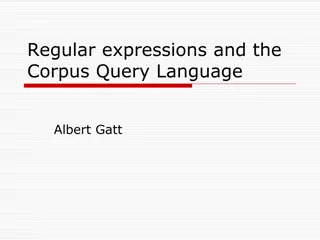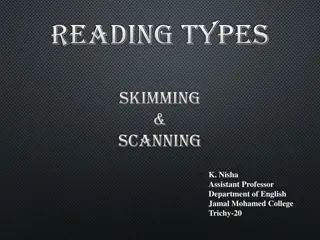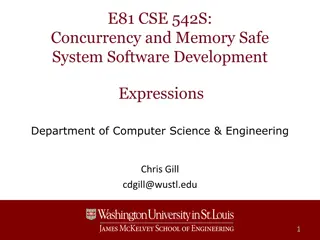Introduction to Lexical Analysis: Scanning and Regular Expressions
This content delves into the key concepts of lexical analysis, emphasizing the process of scanning and recognizing sequences of tokens. Explore the definition, goals, and importance of lexical analysis in automated translation, along with insights on choosing tokens effectively for program analysis.
Download Presentation

Please find below an Image/Link to download the presentation.
The content on the website is provided AS IS for your information and personal use only. It may not be sold, licensed, or shared on other websites without obtaining consent from the author.If you encounter any issues during the download, it is possible that the publisher has removed the file from their server.
You are allowed to download the files provided on this website for personal or commercial use, subject to the condition that they are used lawfully. All files are the property of their respective owners.
The content on the website is provided AS IS for your information and personal use only. It may not be sold, licensed, or shared on other websites without obtaining consent from the author.
E N D
Presentation Transcript
Introduction to Lexical Analysis Scanning and Regular Expressions
Lexical Analysis Definition: reads characters and produces sequences of tokens. Target: Towards automated Lexical Analysis.
First Step First step in any translation: determine whether the text to be translated is well constructed in terms of the input language. Syntax is specified with parts of speech - syntax checking matches parts of speech against a grammar. In natural languages, mapping words to part of speech is idiosyncratic. In formal languages, mapping words to part of speech is syntactic: based on denotation makes this a matter of syntax reserved keywords are important
Goals of Lexical Analysis Convert from physical description of a program into sequence of of tokens. Each token represents one logical piece of the source file a keyword, the name of a variable, etc. Each token is associated with a lexeme. The actual text of the token: 137, int, etc. Each token may have optional attributes. Extra information derived from the text perhaps a numeric value. The token sequence will be used in the parser to recover the program structure.
What Tokens are Useful Here? for (int k = 0; k < myArray[5]; ++k) { cout << k << endl; }
What Tokens are Useful Here? for (int k = 0; k < myArray[5]; ++k) { cout << k << endl; } for int << = ( ) ++ { } ; < [ ]
What Tokens are Useful Here? for (int k = 0; k < myArray[5]; ++k) { cout << k << endl; } for int << = ( ) ++ { } ; < [ ] Identifier IntegerConstant
Choosing Good Tokens Very much dependent on the language. Typically: Give keywords their own tokens. Give different punctuation symbols their own tokens. Group lexemes representing identifiers, numeric constants, strings, etc. into their own groups. Discard irrelevant information (whitespace, comments)
Scanning is Hard FORTRAN: Whitespace is irrelevant DO 5 I = 1,25 DO 5 I = 1.25 Thanks to Prof. AlexAiken
Scanning is Hard FORTRAN: Whitespace is irrelevant DO 5 I = 1,25 DO5I = 1.25 Thanks to Prof. AlexAiken
Scanning is Hard FORTRAN: Whitespace is irrelevant DO 5 I = 1,25 DO5I = 1.25 Can be difficult to tell when to partition input. Thanks to Prof. AlexAiken
Scanning is Hard C + + : Nested template declarations vector<vector<int>> myVector Thanks to Prof. AlexAiken
Scanning is Hard C + + : Nested template declarations vector < vector < int >> myVector Thanks to Prof. AlexAiken
Scanning is Hard C + + : Nested template declarations (vector < (vector < (int >> myVector))) Thanks to Prof. AlexAiken
Scanning is Hard C + + : Nested template declarations (vector < (vector < (int >> myVector))) Again, can be difficult to determine where to split. Thanks to Prof. AlexAiken
Scanning is Hard PL/1: Keywords can be used as identifiers. Thanks to Prof. AlexAiken
Scanning is Hard PL/1: Keywords can be used as identifiers. IF THEN THEN THEN = ELSE; ELSE ELSE = IF Thanks to Prof. AlexAiken
Scanning is Hard PL/1: Keywords can be used as identifiers. IF THEN THEN THEN = ELSE; ELSE ELSE = IF Thanks to Prof. AlexAiken
Scanning is Hard PL/1: Keywords can be used as identifiers. IF THEN THEN THEN = ELSE; ELSE ELSE = IF Can be difficult to determine how to label lexemes. Thanks to Prof. AlexAiken
Challenges in Scanning How do we determine which lexemes are associated with each token? When there are multiple ways we could scan the input, how do we know which one to pick? How do we address these concerns efficiently?
Some Definitions A vocabulary (alphabet) is a finite set of symbols. A string is any finite sequence of symbols from a vocabulary. A language is any set of strings over a fixed vocabulary. A grammar is a finite way of describing a language. A context-free grammar, G, is a 4-tuple, G=(S,N,T,P), where: S: starting symbol N: set of non-terminal symbols T: set of terminal symbols P: set of production rules A language is the set of all terminal productions of G.
Cat Language Example: S=CatWord; N={CatWord}; T={miau}; P={CatWord CatWord miau | miau}
Example: S=E; N={E,T,F}; T={+,*,(,),x} P={E T|E+T, T F|T*F, F (E)|x} Use left most derivation To derive the expression: X + X * X.
Validation To recognise a valid sentence we reverse this process.
Exercise: what language is generated by the (non-context free) grammar: S=S; N={A,B,S}; T={a,b,c}; P={S abc|aAbc, Ab bA, Ac Bbcc, bB Bb, aB aa|aaA} (for the curious: read about Chomsky s Hierarchy)
Why study lexical analysis? To avoid writing lexical analysers (scanners) by hand. To simplify specification and implementation. To understand the underlying techniques and technologies.
Why study lexical analysis? We want to specify lexical patterns (to derive tokens): Some parts are easy: WhiteSpace blank | tab | WhiteSpace blank | WhiteSpace tab Keywords and operators (if, then, =, +) Comments (/* followed by */ in C, // in C++, % in latex, ...) Some parts are more complex: Identifiers (letter followed by - up to n - alphanumerics ) Numbers We need a notation that could lead to an implementation!
Regular Expressions Patterns form a regular language. A regular expression is a way of specifying a regular language. It is a formula that describes a possibly infinite set of strings. Regular Expression (RE) (over a vocabulary V): is a RE denoting the empty set { }. If a V then a is a RE denoting {a}. If r1, r2 are REs then: r1* denotes zero or more occurrences of r1; r1r2 denotes concatenation; r1 | r2 denotes either r1 or r2;
Regular Expressions Shorthands: [a-d] for a | b | c | d; r+ for rr*; r? for r |
Operator Precedence Regular expression operator precedence is (R) R* R1R2 R1| R2 So ab*c|d is parsed as ((a(b*))c)|d
Simple Regular Expressions Suppose the only characters are 0 and1. Here is a regular expression for strings containing 00 as a substring: (0 | 1)*00(0 | 1)*
Simple Regular Expressions Suppose the only characters are 0 and1. Here is a regular expression for strings containing 00 as a substring: (0 | 1)*00(0 | 1)*
Simple Regular Expressions Suppose the only characters are 0 and1. Here is a regular expression for strings containing 00 as a substring: (0 | 1)*00(0 | 1)* 11011100101 0000 11111011110011111
Simple Regular Expressions Suppose the only characters are 0 and1. Here is a regular expression for strings containing 00 as a substring: (0 | 1)*00(0 | 1)* 11011100101 0000 11111011110011111
Simple Regular Expressions Suppose the only characters are 0 and1. Here is a regular expression for strings of length exactly four:
Simple Regular Expressions Suppose the only characters are 0 and1. Here is a regular expression for strings of length exactly four: (0|1)(0|1)(0|1)(0|1)
Simple Regular Expressions Suppose the only characters are 0 and1. Here is a regular expression for strings of length exactly four: (0|1)(0|1)(0|1)(0|1)
Simple Regular Expressions Suppose the only characters are 0 and1. Here is a regular expression for strings of length exactly four: (0|1)(0|1)(0|1)(0|1) 0000 1010 1111 1000
Simple Regular Expressions Suppose the only characters are 0 and1. Here is a regular expression for strings of length exactly four: (0|1)(0|1)(0|1)(0|1) 0000 1010 1111 1000
Simple Regular Expressions Suppose the only characters are 0 and1. Here is a regular expression for strings of length exactly four: (0|1){4} 0000 1010 1111 1000
Simple Regular Expressions Suppose the only characters are 0 and1. Here is a regular expression for strings of length exactly four: (0|1){4} 0000 1010 1111 1000
Simple Regular Expressions Suppose the only characters are 0 and1. Here is a regular expression for strings that contain at most one zero:
Simple Regular Expressions Suppose the only characters are 0 and1. Here is a regular expression for strings that contain at most one zero: 1*(0 | )1*
Simple Regular Expressions Suppose the only characters are 0 and1. Here is a regular expression for strings that contain at most one zero: 1*(0 | )1*
Simple Regular Expressions Suppose the only characters are 0 and1. Here is a regular expression for strings that contain at most one zero: 1*(0 | )1* 11110111 111111 0111 0
Simple Regular Expressions Suppose the only characters are 0 and1. Here is a regular expression for strings that contain at most one zero: 1*(0 | )1* 11110111 111111 0111 0
Simple Regular Expressions Suppose the only characters are 0 and1. Here is a regular expression for strings that contain at most one zero: 1*0?1* 11110111 111111 0111 0
Applied Regular Expressions Suppose our alphabet is a, @, and ., where a represents some letter. A regular expression for email addresses is aa* (.aa*)* @ aa*.aa* (.aa*)*
